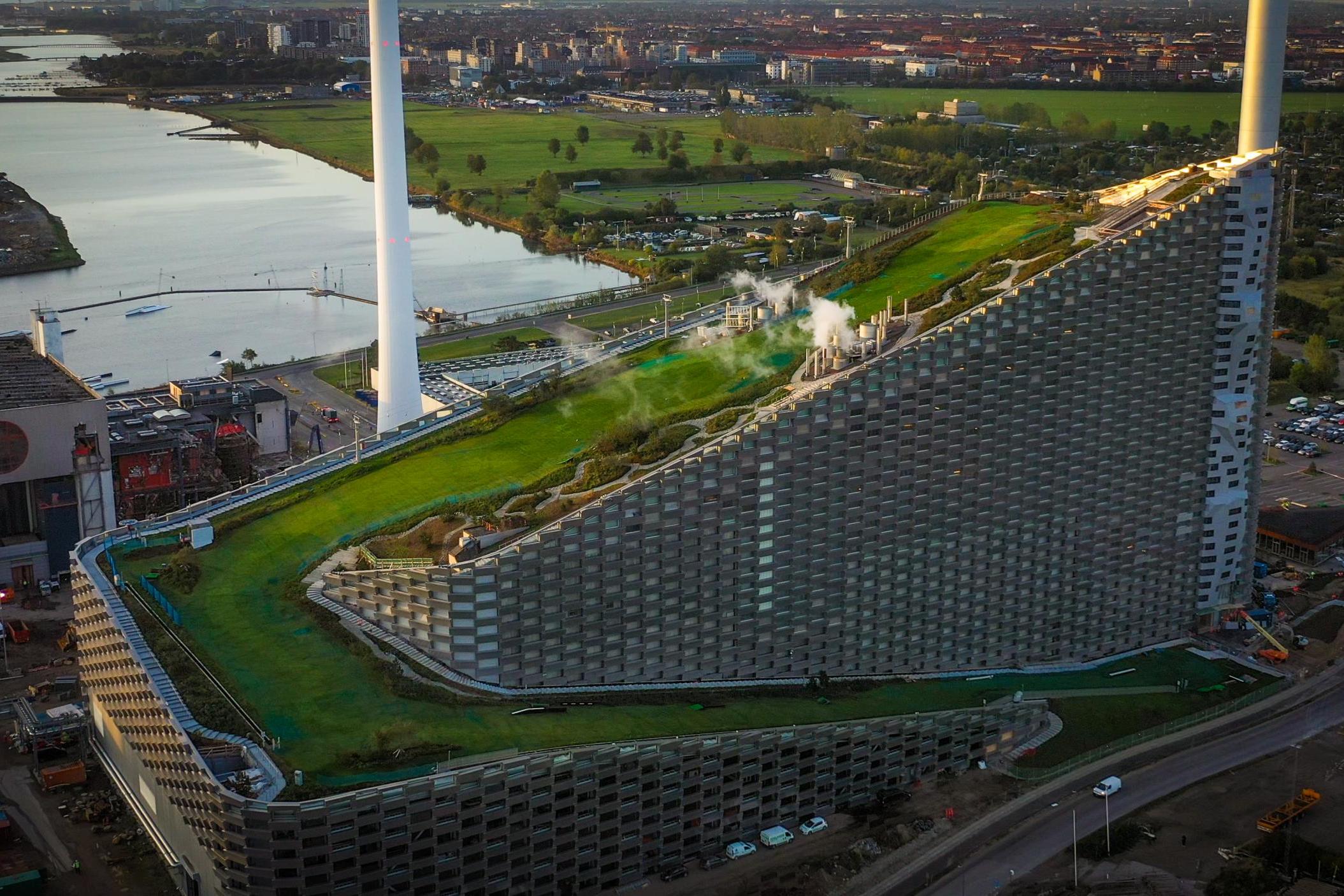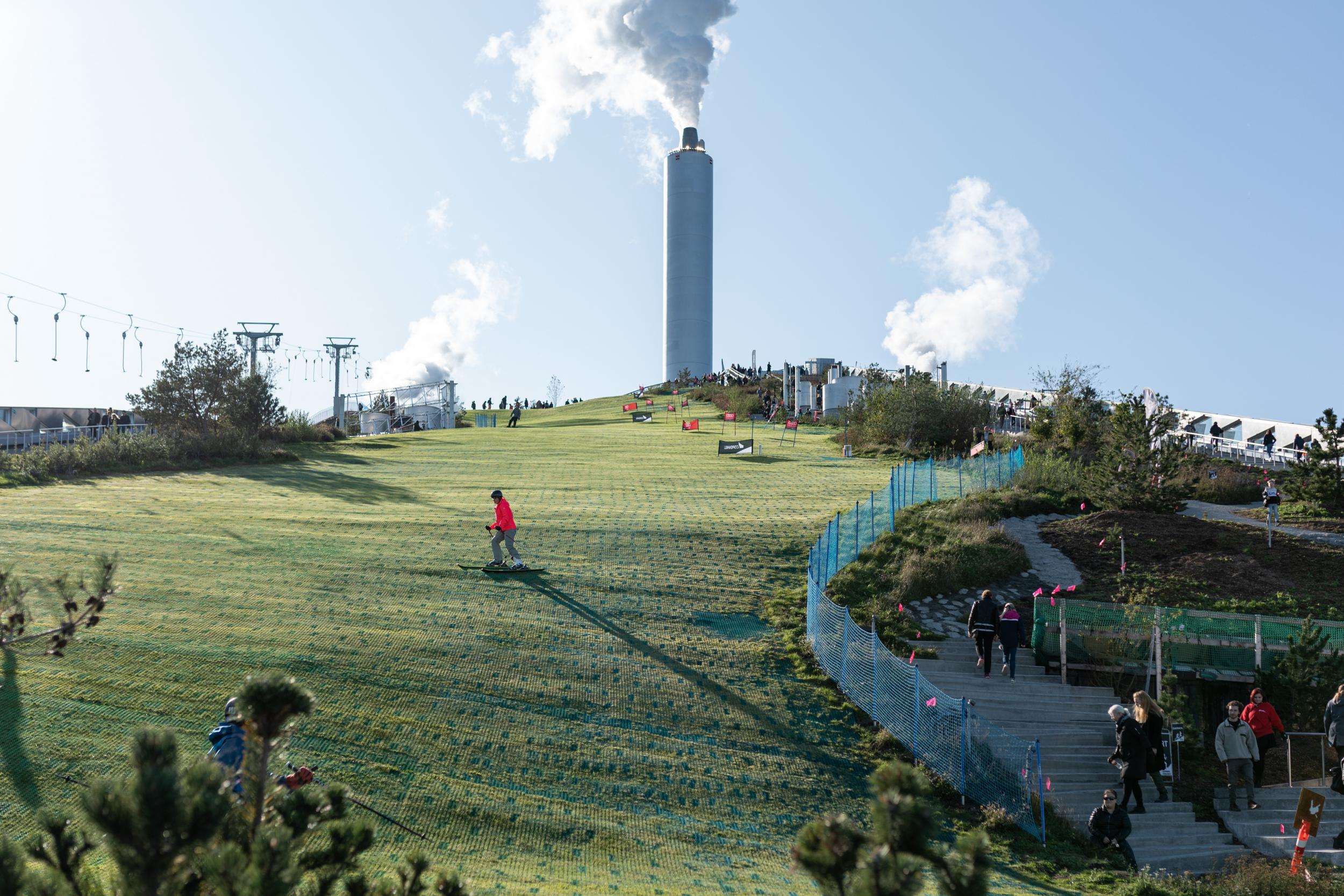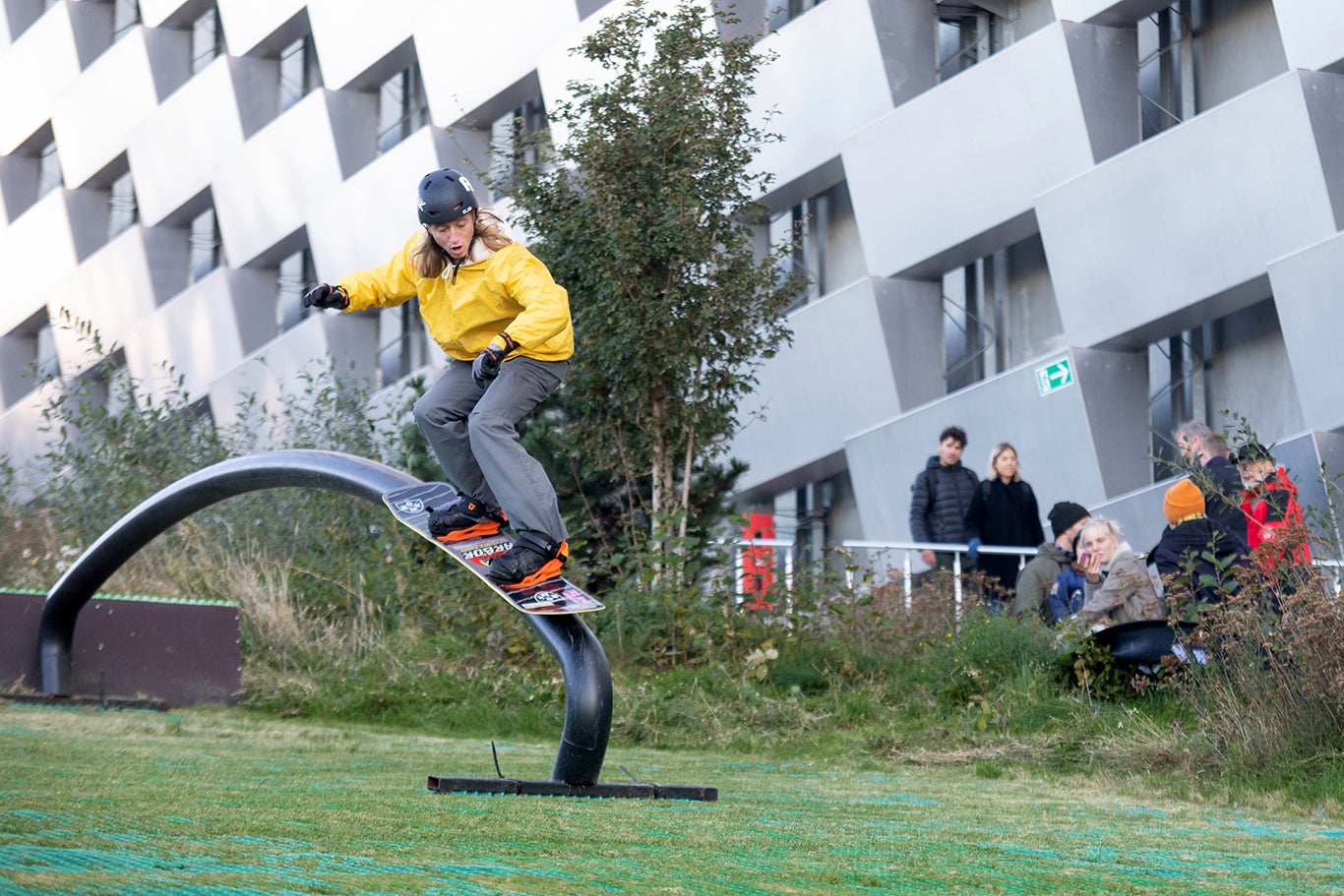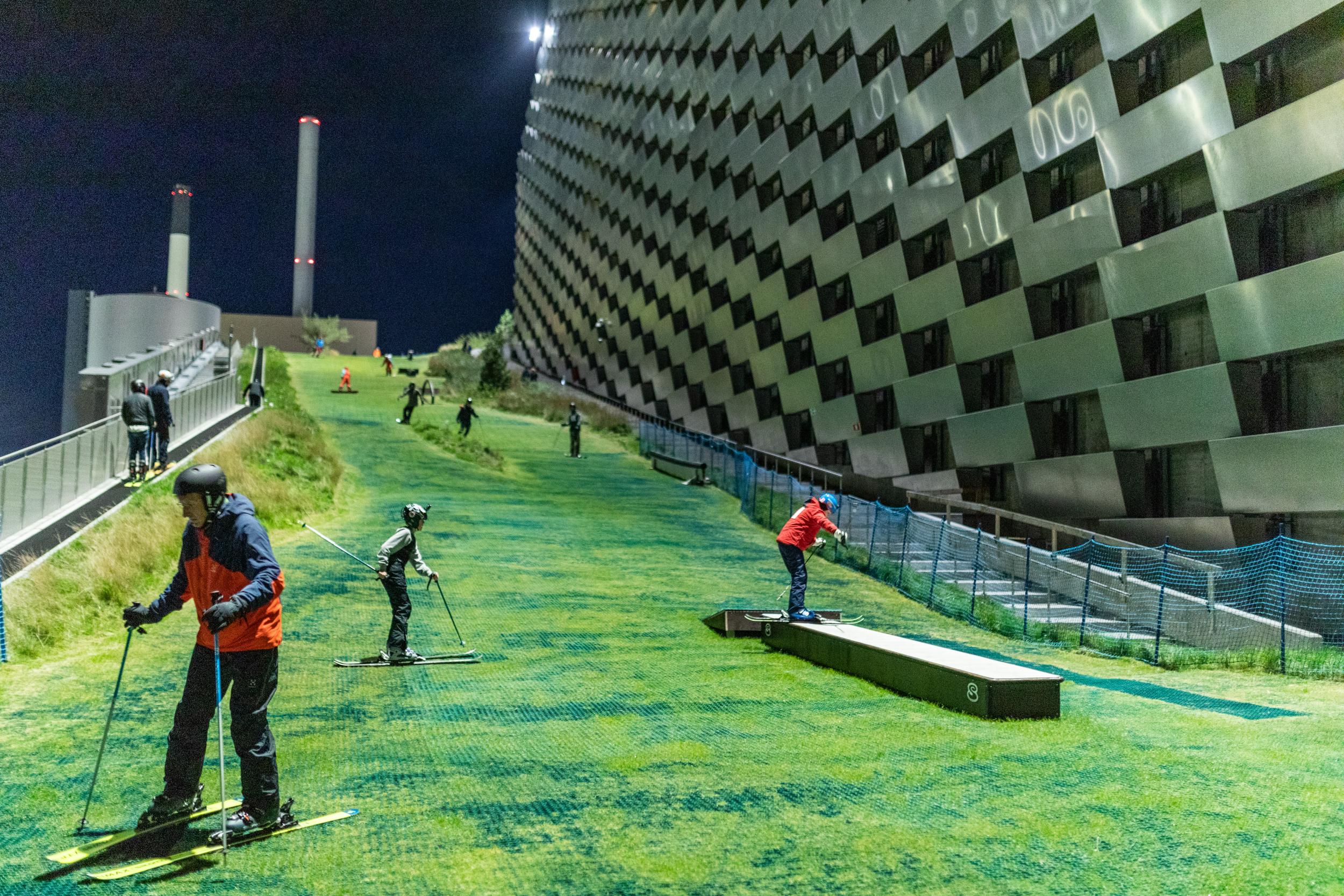What it’s like to ski on Copenhill, Copenhagen’s urban slope on top of a super-green power plant
It’s not all plain sailing, but a visit to Denmark’s most talked-about new building is well worth the bruises, says Jimi Famurewa

Shut your eyes and it could be any ski resort in the world: the crisp, cold air, the clomping passage of ski boots and the occasional crunching hiss of snowboarders and skiers making their way down a hard-packed piste. But open them, look around, and it is a very different story. I may have a snowboard strapped to my feet, as I’m jerked upward by a button lift, but I am nearing the summit of a sleek, recently completed metal building rather than a craggy mountain that has stood tall for millennia.
There are glinting factory turrets puffing out clouds of steam beside me; the surrounding vista is of inner-city Copenhagen; my fellow snowboarders and skiers are in jeans (observed by curious tourists peering out from a viewing platform); and, in lieu of actual snow, a grass-tufted river of bristled green plastic snakes all the way down this 400m artificial peak. It is more than a little surreal – like a Philip K Dick futurescape crossed with the Teletubbies. And as I gracelessly push off from the lift, clip my other foot into the bindings, and promptly fall over onto the hard, palm-stinging surface, I am reminded that one of the underreported benefits of pelting down a mountainside in an Alpine resort is that you’re mostly guaranteed a relatively soft landing.
This, for the uninitiated, is Amager Bakke or Copenhill: a spanking new waste-to-energy incinerator that is also home to the Danish capital’s much-publicised first urban ski slope. Initially mooted almost a decade ago and dreamt up by buccaneering starchitect Bjarke Ingels, it is an audacious, £531m act of so-called “hedonistic sustainability”. The sweeping, sloped facility – capable of converting rubbish into electricity and district heating for 150,000 homes annually – is part of a bold broader plan to make Copenhagen a carbon-neutral city by 2025. As borne out by the ensuing mountain of breathless global press (in 2011, Time magazine named it as one of the most innovative ideas of the year), it is, in pure design and architectural terms, a fairly irresistible proposition.

But now that it is finally open to the public – a full year after its original planned opening date – how does it fare as a worthwhile tourist attraction? And can its green, synthetic slope really give skiers or snowboarders a viable, all-weather fix in the heart of one of Europe’s coolest cities? On the Monday following the launch weekend, I was among the first wave to give it a proper whirl.
Copenhill’s first barrier, in some people’s mind, is its location. Set a little out of town in the traditionally industrial but rapidly gentrifying area of Refshaleoen (long called ‘s*** town’ by locals because of its former landfill site), it is the sort of place you’d need to make a determined journey to, rather than stumble across. Not that it is in any sense easily missed. Making the 15-minute bike ride from the city centre, I saw its pluming main turret and shimmery bulk (sheathed in giant aluminium blocks that give it the feel of a giant box grater) dominating the skyline long before I pulled up outside the slope-roofed little apres bar and welcome centre.
Met by Christian Ingels – Copenhill CEO and architect Bjarke’s cousin – I am soon kitted out with equipment, unsteadily aboard one of the magic carpet lifts that serve the 85m structure’s lower area and receiving an insight into the details of construction.
“These are all traditional Nordic plants,” notes Ingels, as we glide past the flowers, trees and bushes that fringe the piste, up towards a dazzling blue sky. “And the dry slope is an Italian material called Neveplast that is stiff but slips like snow when you put a board or a ski on it.”

As proven by that initial tumble, the grass-like surface isn’t as cosy as it looks. But having picked myself up and regarded the mottled, lightly bruised palms of my hands (some advice: bring gloves) I began to very slowly get the hang of it. The steep top section (which is roughly categorised as the equivalent of a red or black run) has an unforgiving gradient and the fine margins of ice but, as I flow into the more gentle final section, I’m scraping out some nice linked turns and picking up speed as nearby kids on skis fly over jumps.
“It takes quite a few runs to get used to,” explains Ingels as we go up again. “And speed is your friend.” This last part is helped by little black pads, saturated with sticky silicone to boost your glide.
As I go up and down a few more times – and acquaint my backside with the artificial slope more than once – I’m increasingly certain that Copenhill’s slope is, of course, no real replacement for a proper piste, sparkling in fresh, soft powder. But, as a training exercise, it is strangely addictive; a beast that you desperately want to tame. And even if you don’t ski or snowboard it is worth a visit, if only to make your way up the hiking trails that gird the piste, and peer through wisps of steam at a surreal, sci-fi panorama stretching over the water towards Sweden. That said, I would recommend braving the slope if you can. Because, really, witnessing a marvel of modern design is one thing. But flinging yourself down the back of it is something else.

Travel essentials
Getting there
There are daily flights to Copenhagen from London airports, Manchester, Birmingham, Edinburgh and Aberdeen. One way tickets from £15 with Ryanair and from £36 with SAS.
Staying there
CitizenM on the City Hall Square has the budget boutique brand’s usual quirky functionality (hello in-room cuddly toys and expertly curated shop) with the added benefit of a prime central location and welcoming, book-piled lounge area. Doubles from £86.
Elsewhere, for something more distinctive, head to the brewery-adjacent Carlsberg district for Hotel Ottilia’s brutalist decor and showstopping rooftop bar and restaurant. Doubles from £112.
More information
Skiing or snowboarding at Copenhill is £18 an hour and a reusable key card is £6. Make sure to soothe any aching muscles nearby at CopenHot, a hit wellness spot with a rustic vibe, wood-fired saunas and hot tubs and a chance to earn Scandi points by diving into the icy sea.
The Independent’s hotel recommendations are unbiased, independent advice you can trust. On some occasions, we earn revenue if you click the links and book, but we never allow this to affect our coverage
Join our commenting forum
Join thought-provoking conversations, follow other Independent readers and see their replies
Comments